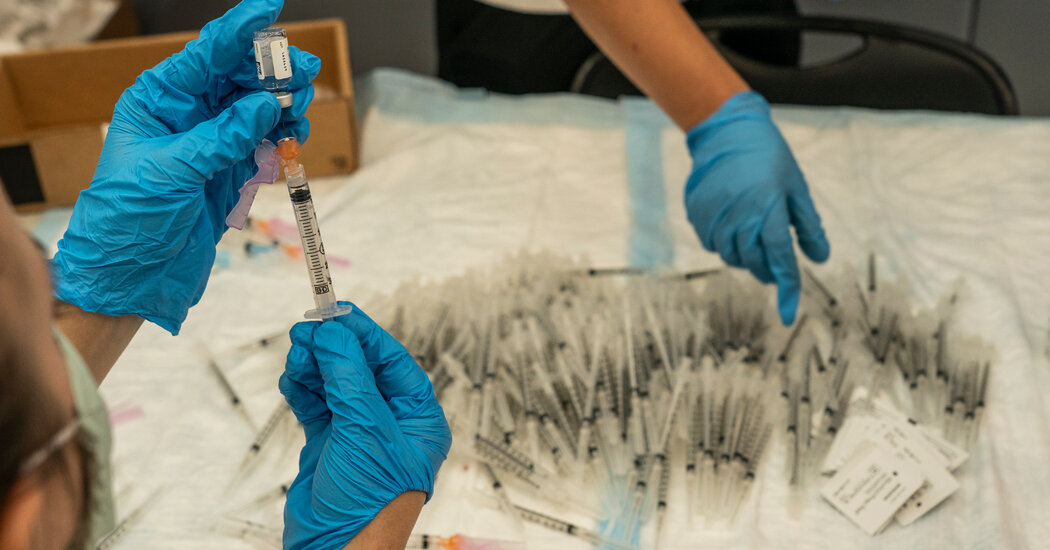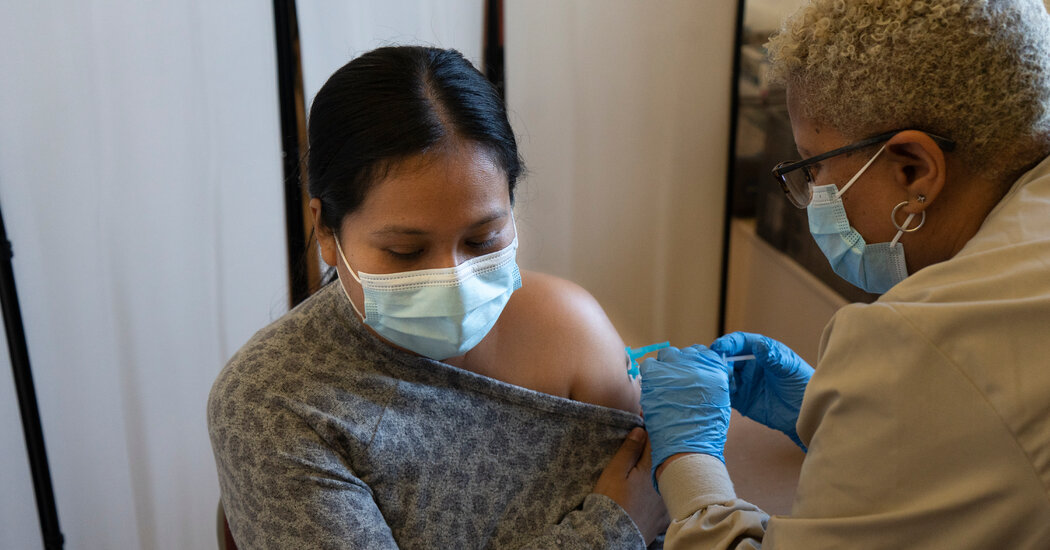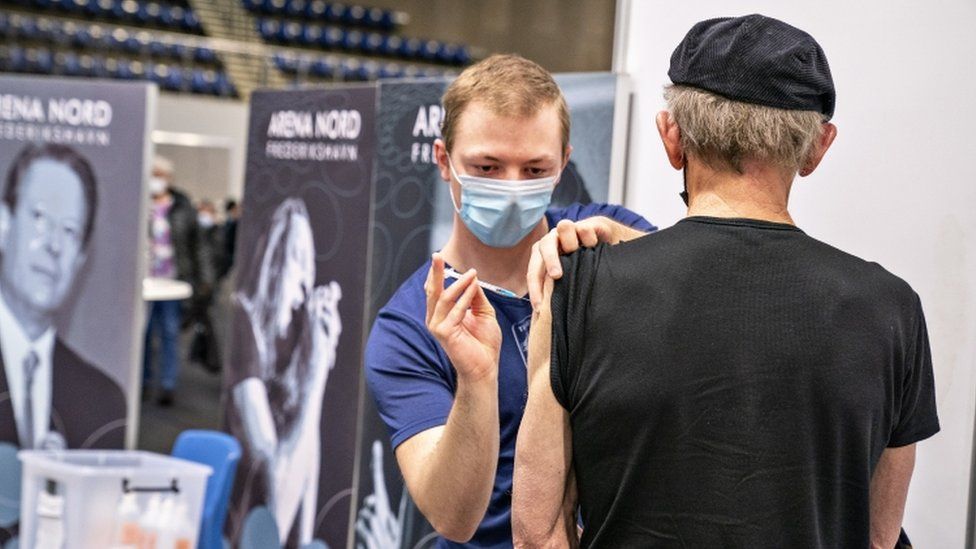Can it affect mammograms or the timing of fertility treatments? What side effects should you look out for? Experts weigh in.News that six women developed a rare blood clotting disorder after receiving Johnson & Johnson’s Covid-19 vaccine has prompted new questions about whether vaccines affect women differently than men, and whether there are special considerations that women should take into account when getting vaccinated. We spoke with a few experts to learn what women should know as they become eligible to get their shots.We don’t yet know if the blood clots affect women more than men. Federal health agencies on Tuesday recommended that practitioners pause administering the Johnson & Johnson vaccine after a half-dozen women developed a rare blood clotting disorder about two weeks after vaccination. The recipients were between the ages of 18 and 48; one woman died and a second was hospitalized in critical condition.But it is not clear if the clotting was caused by the vaccines or whether women are necessarily more often affected. In Europe, it initially appeared that women were at greater risk for blood clots associated with the AstraZeneca-Oxford vaccine, which has not been authorized for use yet in the United States, but it turned out that more women were getting the vaccine overall in some countries. British regulators now say that they don’t have evidence to say whether men or women are more likely to be affected by blood clots.Anyone who has a severe headache, abdominal pain, shortness of breath or leg pain after receiving the Johnson & Johnson vaccine should call their health care provider.Getting vaccinated can change the way your mammogram looks.Coronavirus vaccinations can cause enlarged lymph nodes in the armpit that will show up as white blobs on mammograms. This type of swelling is a normal reaction to the vaccine and will typically occur on the same side as the arm where the shot was given, said Dr. Geeta Swamy, a maternal-fetal medicine specialist and a member of the American College of Obstetricians and Gynecologists’s Covid vaccine group. It usually only lasts for a few weeks.But the vaccine’s effect on mammograms can be concerning to radiologists, she added, because “if someone had breast cancer we might see enlarged lymph nodes as well.”Because this type of swelling could be mistaken as a sign of cancer, the Society of Breast Imaging recommends trying to schedule your routine mammogram before your first Covid-19 vaccine dose or at least one month after your second vaccine dose.“I am particularly eager to get the word out to all the patients undergoing surveillance after successful prior treatment of cancer,” Dr. Constance D. Lehman, who has written about the problem and is the chief of breast imaging at Massachusetts General Hospital, told The New York Times in March. “I can’t imagine the anxiety of getting the scan and hearing, ‘We found a node that is large. We don’t think it’s cancer but can’t tell.’ Or worse, ‘We think it might be cancer.’”But say you are getting a diagnostic mammogram because of a suspicious lump or other symptoms of breast cancer disease or you are someone who had been treated for breast cancer and needs to get regular exams; in those cases, “do not delay,” Dr. Swamy said. You should keep your current mammogram appointment as well as your vaccination appointment, and tell your radiologist the date that you received the vaccine.Fertility patients should coordinate the timing of their vaccine with their clinic.Fertility patients who are scheduled for procedures like egg retrieval, embryo transfer or intrauterine insemination are advised to avoid getting a Covid vaccine within three days before and three days after the procedure, according to the American Society for Reproductive Medicine.That’s because patients undergoing surgical procedures could develop vaccine-related side effects like fever or chills that might make it difficult for doctors to know if a post-surgical infection is brewing. In addition, many medical providers may not allow a patient who is experiencing Covid-like symptoms into their facility, even if it’s likely that the symptoms are from a vaccine and their Covid-19 test is negative.If you manage to get a vaccine appointment and you are scheduled to undergo a fertility procedure, tell your fertility doctor right away so that you can plan any surgical procedures, testing or treatment.All timing issues aside, getting vaccinated is the right thing to do, experts say. Based on all of the reassuring evidence to date, when it comes to fertility or pregnancy, “there are no known safety concerns with the vaccine,” said Dr. Sigal Klipstein, a reproductive endocrinologist in Chicago who is a member of the American Society for Reproductive Medicine Covid-19 Task Force.“Women who contract Covid during pregnancy are at increased risk for more severe disease compared to women who get Covid when they’re not pregnant,” she added.The American College of Obstetricians and Gynecologists said in a statement on Tuesday that for the time being, pregnant and postpartum women who want to be vaccinated should be encouraged to get either the Pfizer-BioNTech or Moderna shots, not the Johnson & Johnson vaccination.If one of your vaccine shots is scheduled during the “two-week wait” — the period of time between ovulation and your expected period when the embryo would implant in the uterus — don’t worry, even if you develop side effects from the vaccine.“Fever should not interfere with implantation,” Dr. Klipstein said.Try not to take any painkillers ahead of time in anticipation of vaccine-related symptoms like fever or headache, because it is believed to dampen your body’s immune response. After the vaccine, it is OK to take acetaminophen, which is considered safe during pregnancy. Women who are pregnant or potentially pregnant should avoid ibuprofen, Dr. Klipstein said..css-1xzcza9{list-style-type:disc;padding-inline-start:1em;}.css-rqynmc{font-family:nyt-franklin,helvetica,arial,sans-serif;font-size:0.9375rem;line-height:1.25rem;color:#333;margin-bottom:0.78125rem;}@media (min-width:740px){.css-rqynmc{font-size:1.0625rem;line-height:1.5rem;margin-bottom:0.9375rem;}}.css-rqynmc strong{font-weight:600;}.css-rqynmc em{font-style:italic;}.css-yoay6m{margin:0 auto 5px;font-family:nyt-franklin,helvetica,arial,sans-serif;font-weight:700;font-size:1.125rem;line-height:1.3125rem;color:#121212;}@media (min-width:740px){.css-yoay6m{font-size:1.25rem;line-height:1.4375rem;}}.css-1dg6kl4{margin-top:5px;margin-bottom:15px;}.css-16ed7iq{width:100%;display:-webkit-box;display:-webkit-flex;display:-ms-flexbox;display:flex;-webkit-align-items:center;-webkit-box-align:center;-ms-flex-align:center;align-items:center;-webkit-box-pack:center;-webkit-justify-content:center;-ms-flex-pack:center;justify-content:center;padding:10px 0;background-color:white;}.css-pmm6ed{display:-webkit-box;display:-webkit-flex;display:-ms-flexbox;display:flex;-webkit-align-items:center;-webkit-box-align:center;-ms-flex-align:center;align-items:center;}.css-pmm6ed > :not(:first-child){margin-left:5px;}.css-5gimkt{font-family:nyt-franklin,helvetica,arial,sans-serif;font-size:0.8125rem;font-weight:700;-webkit-letter-spacing:0.03em;-moz-letter-spacing:0.03em;-ms-letter-spacing:0.03em;letter-spacing:0.03em;text-transform:uppercase;color:#333;}.css-5gimkt:after{content:’Collapse’;}.css-rdoyk0{-webkit-transition:all 0.5s ease;transition:all 0.5s ease;-webkit-transform:rotate(180deg);-ms-transform:rotate(180deg);transform:rotate(180deg);}.css-eb027h{max-height:5000px;-webkit-transition:max-height 0.5s ease;transition:max-height 0.5s ease;}.css-6mllg9{-webkit-transition:all 0.5s ease;transition:all 0.5s ease;position:relative;opacity:0;}.css-6mllg9:before{content:”;background-image:linear-gradient(180deg,transparent,#ffffff);background-image:-webkit-linear-gradient(270deg,rgba(255,255,255,0),#ffffff);height:80px;width:100%;position:absolute;bottom:0px;pointer-events:none;}#masthead-bar-one{display:none;}#masthead-bar-one{display:none;}.css-1pd7fgo{background-color:white;border:1px solid #e2e2e2;width:calc(100% – 40px);max-width:600px;margin:1.5rem auto 1.9rem;padding:15px;box-sizing:border-box;}@media (min-width:740px){.css-1pd7fgo{padding:20px;width:100%;}}.css-1pd7fgo:focus{outline:1px solid #e2e2e2;}#NYT_BELOW_MAIN_CONTENT_REGION .css-1pd7fgo{border:none;padding:20px 0 0;border-top:1px solid #121212;}.css-1pd7fgo[data-truncated] .css-rdoyk0{-webkit-transform:rotate(0deg);-ms-transform:rotate(0deg);transform:rotate(0deg);}.css-1pd7fgo[data-truncated] .css-eb027h{max-height:300px;overflow:hidden;-webkit-transition:none;transition:none;}.css-1pd7fgo[data-truncated] .css-5gimkt:after{content:’See more’;}.css-1pd7fgo[data-truncated] .css-6mllg9{opacity:1;}.css-1rh1sk1{margin:0 auto;overflow:hidden;}.css-1rh1sk1 strong{font-weight:700;}.css-1rh1sk1 em{font-style:italic;}.css-1rh1sk1 a{color:#326891;-webkit-text-decoration:underline;text-decoration:underline;text-underline-offset:1px;-webkit-text-decoration-thickness:1px;text-decoration-thickness:1px;-webkit-text-decoration-color:#ccd9e3;text-decoration-color:#ccd9e3;}.css-1rh1sk1 a:visited{color:#333;-webkit-text-decoration-color:#ccc;text-decoration-color:#ccc;}.css-1rh1sk1 a:hover{-webkit-text-decoration:none;text-decoration:none;}Women are questioning whether the vaccine affects their menstrual cycle.Some women say they have observed changes in the flow or timing of their period after getting vaccinated.But so far this is purely anecdotal.“It’s unlikely that the Covid vaccine would affect menstrual cycles, and there’s no plausible biological mechanism by which this would occur. However, there is little data on this topic,” Dr. Klipstein said.Kathryn Clancy, an associate professor of anthropology at the University of Illinois, generated hundreds of responses on Twitter after saying that her period was heavier than usual after her first dose of the Moderna vaccine. She is now collaborating with Katharine Lee, a postdoctoral research scholar at Washington University in St. Louis, to survey women on short-term vaccine side effects related to the menstrual cycle. Their online survey has been available for less than a week and has so far drawn more than 19,000 responses, Dr. Lee said on Wednesday.Periods can be affected by a multitude of factors, including stress, thyroid dysfunction, endometriosis or fibroids. If you have questions about your menstrual cycle, be sure to speak with your doctor.Women appear to have more side effects after vaccination than men.A study by the Centers for Disease Control and Prevention, published in February, examined the Pfizer-BioNTech and Moderna vaccines and found that 79 percent of the side effects reported to the agency came from women, even though only 61 percent of the vaccines had been administered to women.It could be that women are more likely to report side effects than men, said Dr. Sabra L. Klein, a professor of molecular microbiology and immunology at the Johns Hopkins Bloomberg School of Public Health. Or, she added, women might be experiencing side effects to a greater degree. “We’re not sure which it is,” she said.If women are in fact having more side effects than men, there might be a biological explanation: Women and girls can produce up to twice as many antibodies after receiving flu shots and vaccines for measles, mumps and rubella (M.M.R.) and hepatitis A and B, probably because of a mix of factors, including reproductive hormones and genetic differences. A study found that over nearly three decades, women accounted for 80 percent of all adult allergic reactions to vaccines. Similarly, the C.D.C. reported that most of the anaphylactic reactions to Covid-19 vaccines, while rare, have occurred among women. And in a letter published in the New England Journal of Medicine describing the experiences of people who had redness, itching and swelling that began four to 11 days after the first shot of the Moderna vaccine, 10 of the 12 patients were women. It is not clear, however, whether women are more prone to the problem.If you have mild side effects like headache or a low fever, it’s actually a good thing, Dr. Klein said, because it means your immune system is ramping up. A lack of side effects, however, does not mean the vaccine isn’t working. You can share your symptoms or concerns via the C.D.C.’s V-safe app, which records symptoms and provides health check-ins after vaccinations. Medically significant reports sent using V-safe will be followed up by a call from a representative.
Read more →





